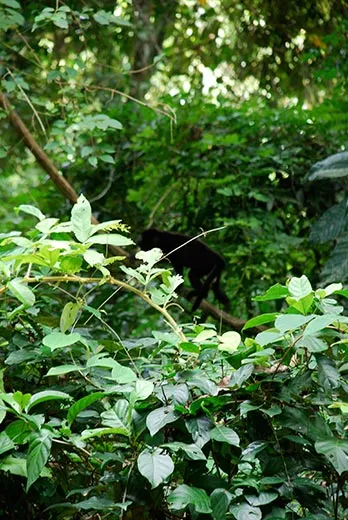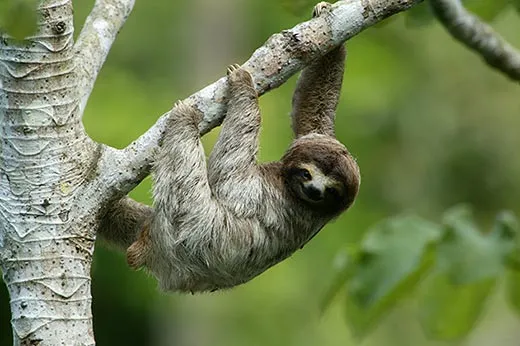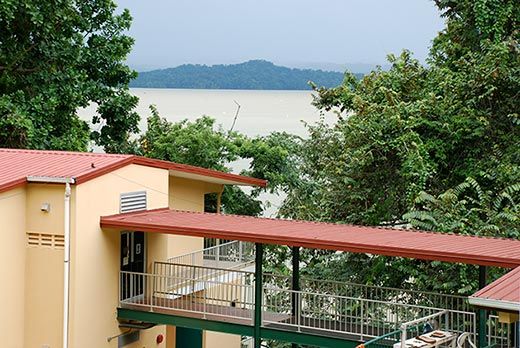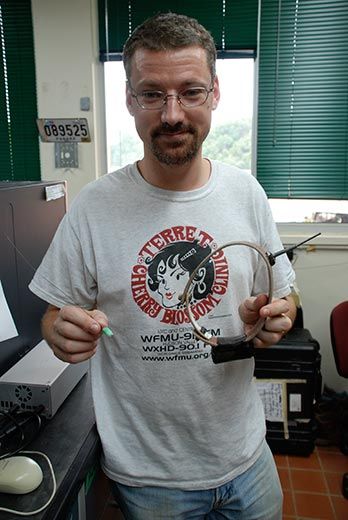How Sleepy Are Sloths and Other Lessons Learned
Smithsonian scientists use radio technology to track animals in an island jungle in the middle of the Panama Canal
/https://tf-cmsv2-smithsonianmag-media.s3.amazonaws.com/filer/Three-toed-sloth-Panama-631.jpg)
Hoots, chirps and the guttural wails of howler monkeys fill the humid, earthy air as we trek deeper. From floor to canopy, the tropical forest is crawling with creatures, and my guide, Robert Horan, keeps a running commentary. Spider monkeys flounce in the tree branches. Two bats cling to the inside of a hollow tree. Stingless bees swarm around a honey-like goop oozing from a freshly cut log. Ant birds keep guard over a bustling ant highway, and a land crab scuttles out of the way of our plodding feet. Not to mention it’s chigger season on Barro Colorado Island.
With all the wildlife vying for my attention, I just about pass the 130-foot radio tower, when Horan calls it out. I tilt my hat back, wipe the sweat from my brow and look up. The tower, like the soaring trees surrounding it, is the first evidence of the island being wired.
An aerial view of the six-square-mile research island in the Panama Canal would reveal six other towers poking through the treetops—all part of a cutting-edge animal surveillance system scientists call the Automated Radio Telemetry System, or ARTS. Atop each tower is an array of antennas that, every few minutes, receives signals from up to 20 radio-tagged animals roaming the forest. The towers then communicate real-time information on the locations and activity levels of the animals to an on-site laboratory.
“It’s better than anything we’ve had before,” explains Horan, a visiting scientist from the University of Georgia.
Roland Kays, curator of mammals at the New York State Museum, and Martin Wikelski, an ecologist at Princeton University, the masterminds behind ARTS, were all too familiar with the limitations of other animal tracking methods. In the past, the scientists spent a sizable amount of time on a variety of projects running through the forest, tracking tagged animals with hand receivers. “You do that long enough, listening to those beeps and collecting relatively little data, and you start thinking, is there some better way?” says Kays.
They researched the radio towers and transmitters and decided that Barro Colorado Island (BCI), where the Smithsonian Tropical Research Institute has an outpost, was the ideal place to test them. The field station, which has been around since the 1960s, has labs that can support the system and dormitories to sleep the nearly 300 scientists who visit and conduct studies on the island each year. The seven towers were erected in 2002, and the first data began streaming into the computer lab in 2003.
Once an animal is collared, the towers check in on the creature every four to five minutes, 24 hours a day, seven days a week. This vigilance allows researchers to know, by a process of triangulation, each tagged animal’s location; whether it’s on the move; what routes it takes; and if it interacts with other tagged animals. When one flat-lines on the computer, researchers know that either it, or its transmitter, is dead and to go out in the forest to assess the damage.
The experiment, perhaps the most groundbreaking to happen in BCI’s storied history, seems a little Jurassic Park meets Nineteen Eighty-Four to me. But Kays insists that the researchers aren’t just sitting there in the lab with their feet on the desk, watching the data come in. “We’re out in the field all the time,” he says.
The two-and-a-half-hour hike Horan and I take is enough to convince me of this. We trek along riverbanks hoping to spot a trolling crocodile or a bathing tapir, but are greeted by some turkey-like crested guan instead. We pass cages along the trail as well. “For catching ocelots,” Horan explains.
The next day, I meet with Ben Hirsch, a post-doc who has just come off of two consecutive nights of trapping and tagging ocelots. He has been working on a project that uses ARTS to study the interactions between ocelots, rodent-like agoutis and the seeds from an island tree called Dipteryx. The agoutis eat some of the seeds and bury others for later. But ocelots prey on the agoutis, thus allowing some of the buried seeds to grow into trees. Hirsch and his colleagues are studying how the balance between the three species is maintained. He takes me to the ARTS lab, in one of the central buildings of the field station, and shows me a computer from which all the tagged animals can be traced. Like a hospital monitor, each jagged line on the screen represents an animal. The color of the line, Hirsch explains, corresponds with the animal’s location on the island; the more drastic the line’s spikes, the more active the individual is. He opens a drawer full of collars, ranging from agouti- to jaguar-size. Swimming amongst them are a few un-collared radio transmitters. I’m reminded of what Kays told me about researchers having to get creative. They glue transmitters to animals too small for collars, like bats. For anteaters, which don’t exactly have a neck, they tried harnesses, but ended up gluing the transmitters to their back ends, out of reach. Of course, depending on the method, a tag can last for mere days to over a year.
Occasionally, scientists at BCI will use GPS tags, an alternative to radio transmitters. And while they do produce a reliable location of the animal, they are expensive, don’t produce live data and are too large to use on many animals. One of the biggest breakthroughs with the radio transmitters is their size. The smallest weighs 300 milligrams—less than a third the weight of a single paper clip—and can be adhered to monarch butterflies and tiny bees. Horan, my hiking companion, has used them to track tree frogs.
ARTS has led to some surprising discoveries. A research team led by Niels Rattenborg, of the Max Planck Institute for Ornithology in Starnberg, Germany, found that sloths aren’t as slothful as originally thought. In captivity, they tend to sleep about 16 hours a day. But in the wild, they average only 9.6 hours.
Behavioral ecologist Meg Crofoot, who currently directs ARTS, uses the system to study white-faced capuchin monkeys. She has learned that when it comes to fights between social groups, victory does not depend on numbers. Regardless of group size, the monkeys closer to their home turf when the battle breaks out are more likely to win.
“ARTS is letting us get at questions that previously just haven’t been answerable using traditional field techniques,” says Crofoot.
Previously, Crofoot would have needed a small army and a massive budget to follow multiple groups of monkeys simultaneously. For this reason, very little is known about competition between social groups. But ARTS was “a new way of getting at this data.” She tagged one or two individuals in six social groups that inhabited the island and was able to trace their every movement. When she wanted to watch a group’s behavior, she could go to the lab, find out where the monkeys were and get there—a huge timesaving measure.
Of course, like any complicated system, ARTS has its kinks. According to Kays, the biggest challenges are keeping the hardware and towers functioning in such a humid environment—vegetation grows on the towers and antennas rust—and studying the sheer amount of data brought in. In the future, he hopes to find a way to automate the data analysis and increase the number of tagged animals the system can handle. Smaller transmitters, for even more insects, he says, wouldn’t hurt either.
“There are so many species that are interacting and doing interesting things,” says Kays. “Coming up with ideas for studies is the easy part.”
/https://tf-cmsv2-smithsonianmag-media.s3.amazonaws.com/accounts/headshot/megan.png)






/https://tf-cmsv2-smithsonianmag-media.s3.amazonaws.com/accounts/headshot/megan.png)